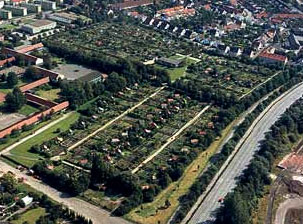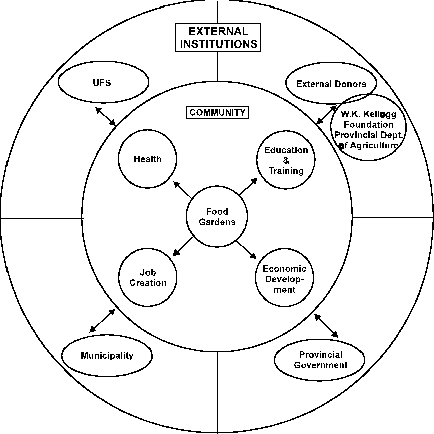The German Allotment Gardens - a Model For Poverty Alleviation and Food Security in Southern African Cities?
A.W. Drescher
axel.drescher@geographie.uni-freiburg.de
Published in the Proceedings of the Sub-Regional Expert Meeting on Urban Horticulture, Stellenbosch, South Africa, January 15 - 19, 2001, FAO/University of Stellenbosch, 2001
Summary
This paper asks whether the German experience with urban allotment gardens (Kleingaerten, Schrebergaerten) in this century can be a model for Southern Africa. Potential exists for urban gardens to help Southern African cities reduce poverty and improve food security and living conditions.
Conditions of hunger and poverty were widespread in Germany and other European countries nearly 200 years ago when the first "gardens for the poor" emerged. Rapid industrialisation, accompanied by urbanisation and migration, forced large numbers of people into dismal living conditions. Urban gardens were one official response.
Allotment gardens consist of a piece of land between 200 and 400 square meters, most of them with a little shed for storing gardening tools. Allotment gardens formed a buffer for food security, especially in times of crisis. Shortly after WW II, Berlin contained 200.000 allotment gardens. Today there are still about 80.000.
The basis for a successful and permanent establishment of allotment gardens was laid through the establishment of associations of small scale gardeners in the cities (Kleingartenvereine, Schrebergartenvereine). The council provides the land, establishes a water system and eventually fences the area. The gardeners pay a small rent for the plot and have to attend to certain duties within the association. The organisation of farmers in garden associations has proved to be a good means for learning democratic rules as well. New development in most German cities heavily promote organic farming and the complete abolishment of pesticide use in public owned urban allotment gardens.
The paper concludes that in principle the adoption of the German system to some Southern African Cities might be possible. Main problems are seen in the institutional context of urban planning and municipal governments. Because of the highly diverse cultural and climatic situation local solutions are needed, e.g. with respect to water management and -harvesting, irrigation techniques, fencing facilities, small scale animal husbandry, and housing regulations. The establishment of allotment gardens is one measure to reduce poverty and site selection has to take immobility of citizens into consideration. Transport is expensive in Southern Africa and for many poor urban dwellers nor affordable. Animal husbandry is still very common in Southern African Cities and closely related to cultural values and habits.
Because at present the major function of the Southern African gardens is food production, quality control of water and soils is pre-requisite for this type of land-use. The establishment of a well-trained extension service that understands the conditions of farming in the urban setting is highly recommended. Urban extension programs in Southern Africa need to be specifically targeted to women farmers ensuring fair proportional access to women, particularly poor, women-headed households. Situation analysis, availability and demand for garden areas in Southern African Cities is required initially. Aiming for sustainable production systems, the integration of organic waste recycling in gardening programmes is most desirable. First step could be to encourage the formation of small, local urban farmers associations and community partnership programmes accompanied by the establishment of trust funds to secure open spaces for food production. To facilitate financing of such programmes public private partnerships could be aimed to and the help of development agencies might additionally contribute.
Keywords: Southern Africa, Germany Allotment Gardens, Schrebergardens, Local Institutions, Food security, Horticulture, Urban Planning, Public Private Partnership
The History of the German Allotment System
The German allotment gardens are plots between 200 and 400 m_ of size mainly used for horticulture and flower production for home consumption. Most of them contain a little shed for storing gardening tools. They are typically clustered within a certain area of the city. Small allotments consist of few plots only while big allotments agglomerate of several hundreds of plots. Animal husbandry and housing are not allowed in German allotment gardens.

Figure 1: A typical German allotment garden
Originally the German allotment gardens are a social public utility. The fight of hunger and poverty stood in the foreground when nearly 200 years ago the first - at that time called "gardens for the poor" - units emerged in Europe. As a consequence of industrialisation, urbanisation and migration numerous persons lived in extraordinarily bad conditions so that even the ruling authorities saw themselves compelled to seize countermeasure (Leutenegger 2000). In the beginning in the 19th century some municipalities gave the poorest a piece of land for vegetable production which they could manage independently. First attempt was made in northern Germany in the city of Kiel. These gardens were seen as an eradicative measure against poverty and riot.
The initiative for the creation of allotments originally came from social engaged personalities and political parties. The medical doctor Daniel Gottlob Moritz Schreber (1808v -1861), is still associated with the idea of allotment gardens in Germany - sometimes they are called "Schrebergardens". He had no idea about gardening but wanted to create possibilities for children in cities to get them away from the streets, bring them on the fresh air and give them a useful occupation. It was the School Director Ernst Innocenz Hauschild, who founded the first gardening association. He took on lease four fields where garden plots were established.
Especially during the first and second world war allotments became extremely important for food security and survival in the cities. Shortly after WW II existed in Berlin nearly 200 000 gardens, today still 80.000 remained.

Figure 2: A typical German allotment scheme from the air (Source BVGF 2000)
In Germany today still more than 1.4 Million organised allotment gardens exist. All together they occupy an area of nearly 47.000 ha (BVGF 2000). Additionally we find millions of private home gardens. Allotments play an important role for the production of fresh fruits and vegetables but also for recreation and conservation of nature in cities. The latter became the most important reason today for the conservation of those gardens in cities. Many of the members of the associations are pensioners. Recent development in Germany shows also a shift in ownership of gardens from German owners to migrants from other countries - like e.g. Russia and other Eastern European Countries. Observations prove differences in the use of allotment gardens between migrants and Germans. Migrants tend to grow much more vegetables and fruits, while Germans generally grow more flowers and use the gardens for recreation.
The Institutional Framework of the German Allotment Movement
All gardeners are organised in associations or garden clubs under the umbrella of the German Leisure Garden Federation which is the parent organisation and interest representation of the allotment and leisure gardeners' associations of Germany. (Bundesverband der Gartenfreunde) with about 1.5 million members. The German Leisure garden federation represents the interests of allotment and leisure gardeners organised in 19 regional organizations and 15.200 associations. (BVGF 2000).
In most German cities we shall find several allotments in different locations. In the past preferred sites were along railway lines, on marshy areas and other ground not used for housing. Each allotment is a self organised unit and members form an association. Each gardener has to be a member of the association, which in the frame of a leasing contract takes over the administration of the so called "garden-colony". If any problem arises this has to be solved within the single associations, according to democratic rules and rules of justice. The single units form a greater unit on the city scale - called the association of allotment gardeners. The administration on city level is organised within the municipality. Only if a problem cannot be solved within the associations it comes to a hearing on the city level.
The members of the allotment association have defined duties and rights. For example the use of the plots is clearly defined to be two third at least for vegetables and one third for flowers and recreation.
Basic requirements for the German system are the provision of land and water as well as certain infrastructure related to accessibility, health and hygiene (drinking water and toilets).
The association is financed through the contributions of each member who has to pay a small yearly rent for his or her plot and an additional obligatory fee to remain member of the association.
Advantages of the system are:- Production of fresh food for household consumption, gaining gardening experience
- Possibilities for recreation within the city boundary (reduces costs for transport and fuel consumption)
- Learning democratic rules in decision making and conflict management
- Promotion of participatory learning processes (learning from each other) which makes extension cheaper and more efficient
- People are reachable because of the specific spatial structure of the allotments
- Possibilities for women to take their children to the allotment, children can learn gardening and
- Promotion of organic farming and abolishment of pesticide use in public owned urban allotment gardens.
Today's significance of the Allotment system in Germany
Recently allotment gardens became less important for food production for most gardeners - they became much more important for recreation. But this does not mean that in future allotments might not become important for food production again.
Crisis in the food system can never be excluded entirely as recently became obvious in Eastern Europe. Here small scale gardening re-gained an great importance for survival because of the miserable economic situation of many countries (compare to Schmidt 1998).
Allotment gardens are seen today in the social, economic and environmental contexts. Allotment gardens recently gained much more importance for social life in German cities. The demographic development in Germany leads to an increase of elderly in the society (ageing process). Life expectancy of about 75 years in average is still on a steady increase. An increased demand for allotment gardens can be foreseen. Unemployment and early retirement often mean exclusion from public society which in many cases is compensated through activities in associations. For poorer families with children the allotment gardens become a great deal of affordable space for recreation. Allotment gardens allow children to experience nature in an active manner. The association's playgrounds are where friendships are sealed with other children; special occasions such as children's parties allow children to partake in the association's activities. This enables them to widen their social skills in a children's environment. The presence of allotment gardens as school gardens or gardens for children gives rise to further educational possibilities (Office International de Coin de Terre 2000a). The allotment movement offers manifold possibilities for the establishment of social contacts not only for single headed households but also for handicapped people and migrants.
In a period where the state withdraws from many social functions, the allotment garden associations could assume important social missions. From this situation flows an obligation for the states to improve the basic conditions of the allotment garden movement. This social obligation corresponds to the common European heritage, the importance of which the Heads of State and Government of the member states of the Council of Europe emphasised in October 1997 (Office International de Coin de Terre, 2000).
Problems faced by the German Allotment System
Where municipalities had no strategy for the acquisition of municipal real estate, conflicts with allotment holders associations tended to become harsh, and sometimes lead to organised political protest (Groening 1996). In Berlin and other German cities, the reason for protection of land for allotments was not due to integration into urban planning, but due to the influence of democrats and the Green party. Land used for allotments gardens in Berlin nevertheless has been reduced by almost 50% since after the war and the loss of other agricultural land (ordinary private or state run farms) which used to cover more than 12% of the city's area was just as dramatic especially in the western part of the city where 75% of this agricultural land was sacrificed to city development. This happened despite the fact, that areas are defined by and integrated into urban planning. In the end plans are just paper and planners are not a very powerful species within the city administration unless supported by a strong popular movement (Ginsberg 2000). Nevertheless it is also said that only 16,6% of the Berlin allotment gardens are secure because integrated in city plans and therefore protected (Mittelstaedt 2000).
Transferability of the System to Southern African Cities
The keys for the transferability of the German allotment system to Southern African Cities is the functioning of local institutions, capacity building of interest groups and the awareness of political responsibilities among local politicians. Partnership community development programmes proved to be successful in South Africa (Nell et al. 2000). According to Nell et al. (2000), the food gardens link up directly with the four major cornerstones of community development: health, education and training, economic development and job creation (Figure 3).

Figure 3: The Community Partnership Development System (Nell et al. 2000).
Additionally the establishment of allotment gardens requires the availability of resources - natural as well as financial. Support through international development aid might be necessary in some poor communities.
Main problems are seen in the institutional context of urban planning and municipal governments. Local urban governments in many African cities are weak institutions. Municipal councils which started off as colonial institutions were never fundamentally transformed to cater for a growing African urban population (UNCHS 1998). With a new view of urban-periurban-rural linkages and the role of periurban areas in development (see Iaquinta & Drescher (2000)) the role of local institutions arrive at the centre of contemplation of development activities. Little is actually known on the functioning of local institutions in the urban-periurban context. It is presumed that those institutions work on a centralised basis, supported by the urban bias, not taking into consideration urban - rural equality. Regarding the situation in periurban areas it is presumed as well, that local periurban institutions (formal or informal) like e.g. farmer groups, water users etc. have little influence on decision making in the nearby urban centre. Capacity building for local institutions and support for the formation of new, more efficient and interdisciplinary institutional approaches towards the urban-rural continuum are therefore needed (Iaquinta & Drescher (2000)). Greater collaboration between research and development capacities in urban planning and those in agricultural development is needed to make urban farming more efficient and sustainable (MOUGEOT 1996). Community gardens which have become part of a zoning plan are harder to relocate (Groening 1996).
Beyond this, there is need to integrate urban food security in the overall aim of sustainable development strategies. This, nevertheless requires interdisciplinary approaches and large scale co-operation towards an enhanced rural-periurban-urban network (Iaquinta & Drescher (2000)).

Figure 4: Poverty in Lusaka/Zambia - a women is gathering for food on a waste disposal site
Due to rapid and uncontrolled growth of African cities, food security becomes more and more a problem. Africa until now is least urbanised, with about 36% only, but shows highest rates of urbanisation presently.
Kampala, Lilongwe and Ibadan show highest poverty levels in Africa with 60 - 80% urban poor. Female headed households show significant higher poverty rates in African cities (WRI 1996). The establishment of allotment gardens is one measure to reduce poverty and site selection has to take immobility of citizens into consideration. In fact, many African citizen rely on small scale gardening, food production and animal husbandry already today. In Southern Africa this is a majority of women. Women tend to dominate urban cultivation because they are marginalized in other forms of employment in the formal sector of the urban economy.
Main actors in peri-urban agriculture are male members of the family, at least in many African countries. Economic crisis and structural adjustment policies introduced in developing countries have had a disproportionate impact on the urban poor, as they have resulted in rising food prices, declining real wages, redundancy in the formal labour market, and reduced public expenditure on basic services and infrastructure. It is often, that economic crisis has different impacts on women and men (Iaquinta & Drescher (2000)).
Requirements for transferability and need for local adaptations
The establishment of allotment gardens needs water and space as basic requirements. The inclusion of open spaces in urban planning and their protection requires protective laws and regulations. To better enable financial requirements public private partnerships are proposed to be established. This can be partnerships between electricity companies, waste and health departments or councils and community gardeners.
Power lines are non-housing areas in most countries and are known to be potential illegal waste disposal sites, similar to river banks. Community gardens can prevent such areas from pollution as examples form Tanzania prove.
Recycling of organic solid waste is an effective and sustainable way of improving soil fertility and prevent high costs and space for disposal. Decentralised composting facilities might be another way of public private partnerships and are most desirable.
Animal husbandry needs to be integrated in a sustainable and environmental sound way because chicken meat and eggs are important but expensive components of many Southern African Communities.
Because at present the major function of the Southern African gardens is food production, quality control of water and soils is pre-requisite for this type of land-use. The establishment of a well-trained extension service that understands the conditions of farming in the urban setting is highly recommended. Urban extension programs in Southern Africa need to be specifically targeted to women farmers ensuring fair proportional access to women, particularly poor, women-headed households (Drescher 1996). Situation analysis, availability of space and water and demand for garden areas in Southern African Cities is required initially. First step could be to encourage the formation of small, local urban farmers associations and community partnership programmes accompanied by the establishment of trust funds to secure open spaces for food production. Good and successful experience in food gardening and partnership community programmes are available from Bloemfontein (Nell et al. 2000).
Because of the highly diverse cultural and climatic situation local solutions are needed, e.g. with respect to water management - preservation and -harvesting, irrigation techniques, fencing facilities, small scale animal husbandry, and housing regulations. For support, techniques for improved water use efficiency show high potential. Such technologies are partly available elsewhere but need to be adapted to the local conditions through participatory research and technology development (Drescher et al. 1999).
Conclusions
Food security in Southern African cities is a topic that needs to be addressed urgently. Due to the rapid growth of Southern African Cities, basic needs of the citizen (shelter, food, education etc) tend to be undermined and local authorities find themselves in the difficult situation to face ungovernable conditions.
Under consideration of cultural norms and traditions, climatic conditions and natural resource settings the establishment of allotment gardens could help to reduce poverty and improve food security in cities. This proved the European experience with the establishment of such systems during times of crisis. The idea of transferring the European model for community food security in urban areas is not new. Similar attempts were made in Eastern Europe (Chatwin 1998). Experience shows that garden schemes enable to a great extend the establishment of participatory community development programmes and allow the introduction of democratic rules related to the management of the plots. Special participatory training programmes can further contribute to community building. Nevertheless this process needs monitoring and moderation.
In Southern Africa, female headed households as a group most affected by poverty might be a special target group to be interested and integrated into allotment programmes.
Discussion on this issue helps to create public awareness among planners and city councils. Urban food production needs to be seen under the various aspects of urban food security, poverty alleviation, environmental protection, recreation, job creation and crime reduction. A careful analysis and comparison of past failed and successful efforts in the same direction is needed.
References
BVGF (2000): Bundesverband der Gartenfreunde e.V. (2000): http://www.jardins-familiaux.org/ger/ger_4_d.htm
Chatwin, Mary Ellen (1998): Family allotment gardens in Georgia: introduction of a European model for community food security in urban areas. The WBI's CBNRM Initiative. The World Bank. http://srdis.ciesin.org/cases/georgia-001.html
Drescher, A.W. (1996): Management Strategies in African Homegardens and the Need for new Extension Approaches. In: Heidhues, F. & A. Fadani: Food Security and Innovations - Successes and Lessons learned. Peter Lang, Frankfurt: 231-246.
Drescher, A.W., J. Hagmann & E. Chuma (1999): Home gardens - a Neglected Potential for Food Security and Sustainable Land Management in the Communal Lands of Zimbabwe. In: Der Tropenlandwirt, 2/1999: 163-180. Kassel-Witzenhausen.
Ginsberg, Oliver (2000): ), Contribution to the FAO/ETC Electronic Conference "Urban and Peri-urban Agriculture on the Policy Agenda" - UPA-Planning-Group. www.fao.org/urbanag
Groening, Gert (1996): Politics of Community Gardening in Germany. Paper presented at the 1996 Annual Conference of The American Community Gardening Association (ACGA) "Branching Out: Linking Communities Through Gardening", September 26 - 29, 1996, Montréal, Canada (http://www.cityfarmer.org/german99.html#develpgerman)
Iaquinta, D. & A.W. Drescher (2000): Defining peri-urban: Towards Guidelines for understanding rural urban linkages and their connection to institutional context. Land Reform 2000/2, United Nations Food and Agriculture Organisation (FAO), Rome.
Leutenegger, Martin (2000): Vom Armengarten zum grünen Paradies? Internetpublication: catmedien: http://www.catmedien.ch/content/aktuell/2000/schrebergaerten2400.html
Mittelstaedt, Siegfried (2000): Comment in http://www.berlinonline.de/forum/gaestebuch/
Mougeot, L. (1996): Introduction: An improving domestic and international environment for African urban agriculture. In: Mougeot, L. (ed.): African Urban Quarterly, Special Issue: Urban Agriculture in Africa, Vol. 11, No. 2 & 3: 137-152.
Nell, W.T., S.J. Wessels & J. Mokoka (2000): Community development in the 21st century - food garden management. (copy retrieved from Authors)
Office International de Coin de Terre (2000): Resolution of the 32nd congress of the Office International du Coin de Terre et des Jardins Familiaux a.s.b.l., Lausanne August 24th - 26th, 2000
Office International de Coin de Terre (2000) : Memorandum of Vienna "Thoughts on the situation and development of the allotment garden movement in Europe" Office International du Coin de Terre et des Jardins Familiaux a.s.b.l. http://www.jardins-familiaux.org/int/int_8_e.htm
Schmidt, Anja (1998): Straßenkinder in Rußland Hintergründe, Lebenssituation und Hilfsansätze am Beispiel von St. Petersburg, Diplomarbeit im Fachbereich Sozialwesen der FH Potsdam (1998)
UNCHS (1998): Privatization of municipal services in East Africa: A Governance Approach to Human Settlements Management. United Nations Centre for Human Settlements (Habitat) Nairobi, Kenya.
WRI (1996): World Resources 1996-97: The Urban Environment. United Nations Human Development Report; World Resource Institute, Washington DC.
We ensure you 100% success by using our incredible 70-573 pdf and 70-693 vce study packages. We are also offering the best 70-401 vce, exam 70-685 and 70-662 vce dumps training solutions for final exams.
![[new]](new01.gif)
